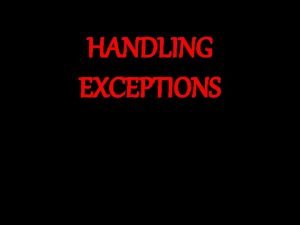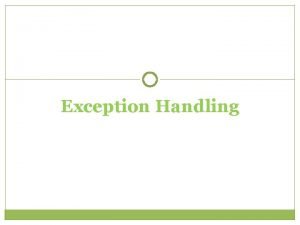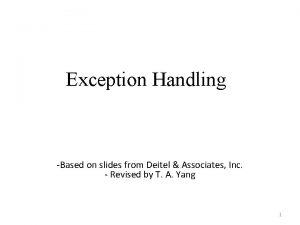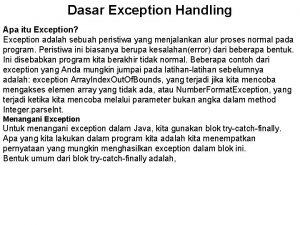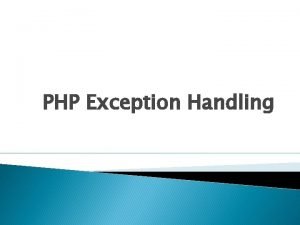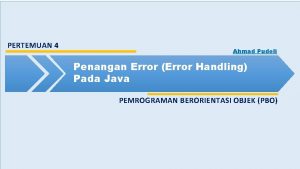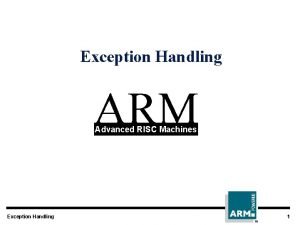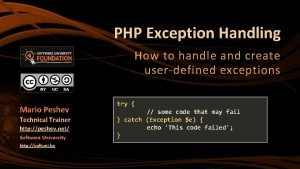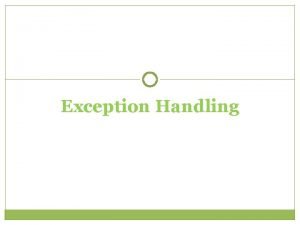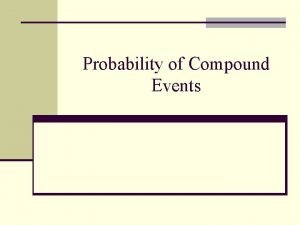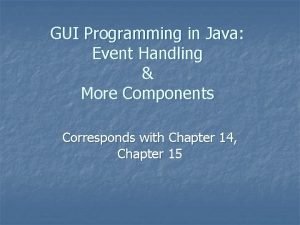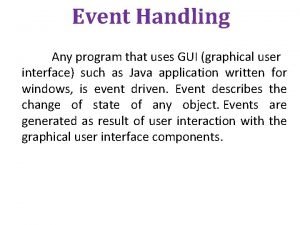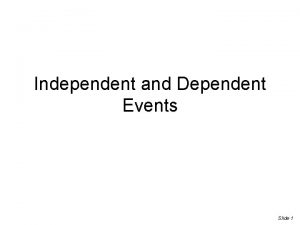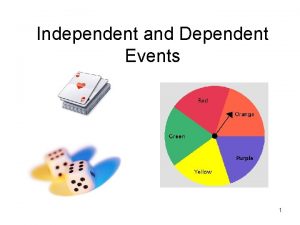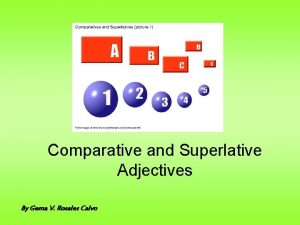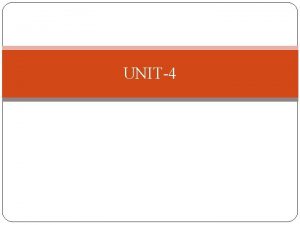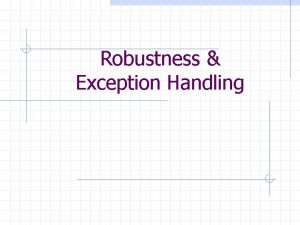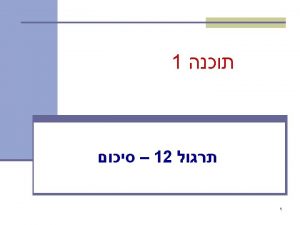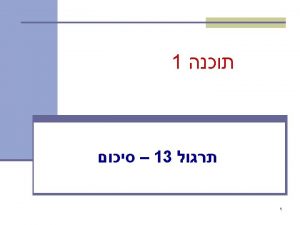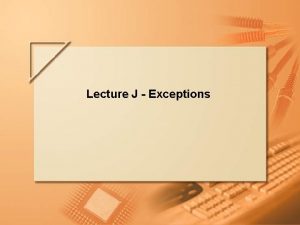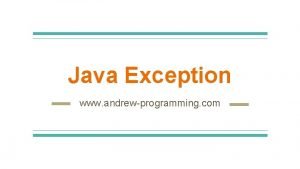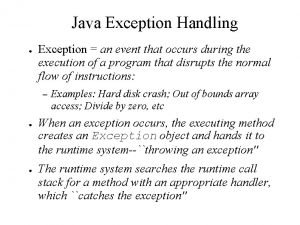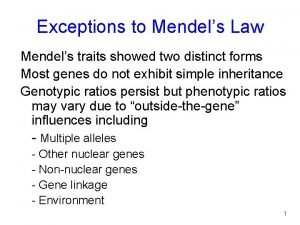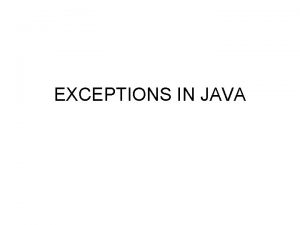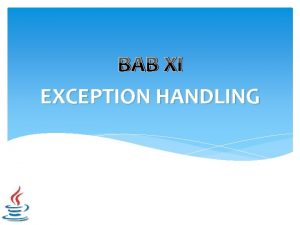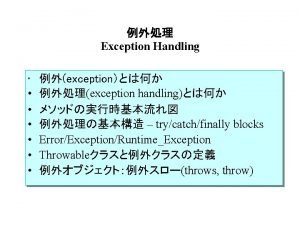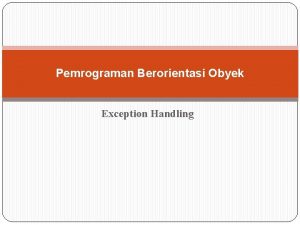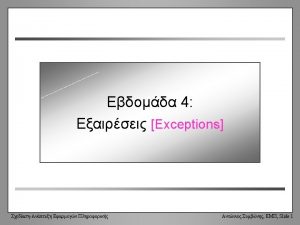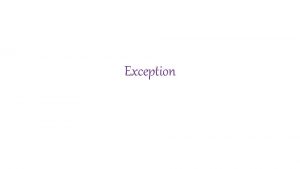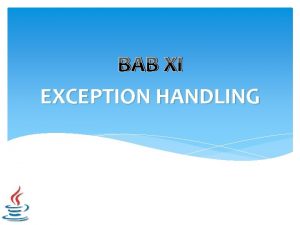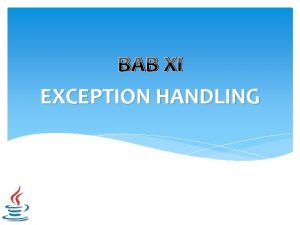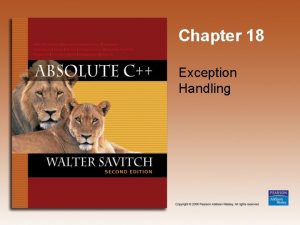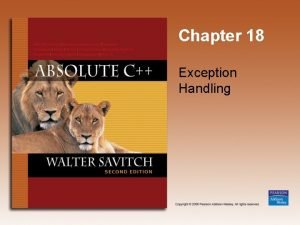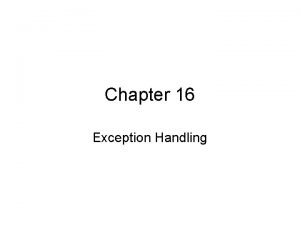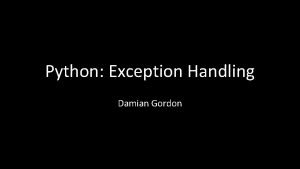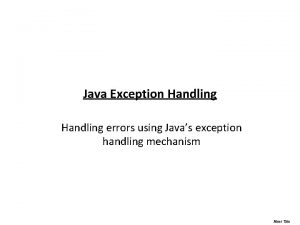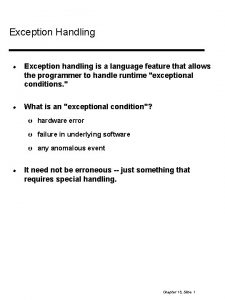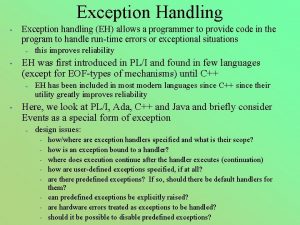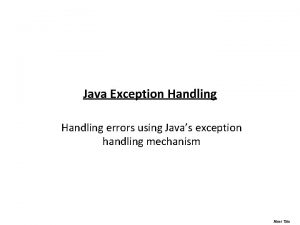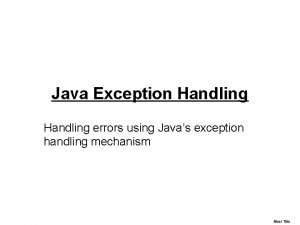Chapter 14 Exception Handling and Event Handling Chapter


















![Throwing Exceptions • Exceptions are all raised explicitly by the statement: throw [expression]; • Throwing Exceptions • Exceptions are all raised explicitly by the statement: throw [expression]; •](https://slidetodoc.com/presentation_image/12431a468c0114ff57a13f2c8071ba4e/image-19.jpg)

















- Slides: 36

Chapter 14 Exception Handling and Event Handling

Chapter 14 Topics • • Introduction to Exception Handling in Ada Exception Handling in C++ Exception Handling in Java Introduction to Event Handling with Java Event Handling in C# Copyright © 2012 Addison-Wesley. All rights reserved. 1 -2

Introduction to Exception Handling • In a language without exception handling – When an exception occurs, control goes to the operating system, where a message is displayed and the program is terminated • In a language with exception handling – Programs are allowed to trap some exceptions, thereby providing the possibility of fixing the problem and continuing Copyright © 2012 Addison-Wesley. All rights reserved. 1 -3

Basic Concepts • Many languages allow programs to trap input/output errors (including EOF) • An exception is any unusual event, either erroneous or not, detectable by either hardware or software, that may require special processing • The special processing that may be required after detection of an exception is called exception handling • The exception handling code unit is called an exception handler Copyright © 2012 Addison-Wesley. All rights reserved. 1 -4

Exception Handling Alternatives • An exception is raised when its associated event occurs • A language that does not have exception handling capabilities can still define, detect, raise, and handle exceptions (user defined, software detected) • Alternatives: – Send an auxiliary parameter or use the return value to indicate the return status of a subprogram – Pass an exception handling subprogram to all subprograms Copyright © 2012 Addison-Wesley. All rights reserved. 1 -5

Advantages of Built-in Exception Handling • Error detection code is tedious to write and it clutters the program • Exception handling encourages programmers to consider many different possible errors • Exception propagation allows a high level of reuse of exception handling code Copyright © 2012 Addison-Wesley. All rights reserved. 1 -6

Design Issues • How and where are exception handlers specified and what is their scope? • How is an exception occurrence bound to an exception handler? • Can information about the exception be passed to the handler? • Where does execution continue, if at all, after an exception handler completes its execution? (continuation vs. resumption) • Is some form of finalization provided? Copyright © 2012 Addison-Wesley. All rights reserved. 1 -7

Design Issues (continued) • How are user-defined exceptions specified? • Should there be default exception handlers for programs that do not provide their own? • Can predefined exceptions be explicitly raised? • Are hardware-detectable errors treated as exceptions that can be handled? • Are there any predefined exceptions? • How can exceptions be disabled, if at all? Copyright © 2012 Addison-Wesley. All rights reserved. 1 -8

Exception Handling in Ada • The frame of an exception handler in Ada is either a subprogram body, a package body, a task, or a block • Because exception handlers are usually local to the code in which the exception can be raised, they do not have parameters Copyright © 2012 Addison-Wesley. All rights reserved. 1 -9

Ada Exception Handlers Begin. . exception when exception_choice{|exception_choice} => statement_sequence; end; Copyright © 2012 Addison-Wesley. All rights reserved. 1 -10

Binding Exceptions to Handlers • If the block or unit in which an exception is raised does not have a handler for that exception, the exception is propagated elsewhere to be handled – Procedures - propagate it to the caller – Blocks - propagate it to the scope in which it appears – Package body - propagate it to the declaration part of the unit that declared the package (if it is a library unit, the program is terminated) – Task - no propagation; if it has a handler, execute it; in either case, mark it "completed" Copyright © 2012 Addison-Wesley. All rights reserved. 1 -11

Continuation • The block or unit that raises an exception but does not handle it is always terminated (also any block or unit to which it is propagated that does not handle it) Copyright © 2012 Addison-Wesley. All rights reserved. 1 -12

Other Design Choices • User-defined Exceptions form: exception_name_list : exception; • Raising Exceptions form: raise [exception_name] – (the exception name is not required if it is in a handler--in this case, it propagates the same exception) • Exception conditions can be disabled with: pragma SUPPRESS(exception_list) Copyright © 2012 Addison-Wesley. All rights reserved. 1 -13

Predefined Exceptions • Constraint_Error - index constraints, range constraints, etc. • Program_Error - call to a subprogram whose body has not been elaborated • Storage_Error - system runs out of heap • Tasking_Error - an error associated with tasks Copyright © 2012 Addison-Wesley. All rights reserved. 1 -14

Evaluation • The Ada design for exception handling embodies the state-of-the-art in language design in 1980 • Ada was the only widely used language with exception handling until it was added to C++ • The propagation model allows exceptions to be propagated to an outer scope in which the exception would not be visible • It is not always possible to determine the origin of propagated exceptions • Exception handling is inadequate for tasks Copyright © 2012 Addison-Wesley. All rights reserved. 1 -15

Exception Handling in C++ • Added to C++ in 1990 • Design is based on that of CLU, Ada, and ML Copyright © 2012 Addison-Wesley. All rights reserved. 1 -16

C++ Exception Handlers • Exception Handlers Form: try { -- code that is expected to raise an exception } catch (formal parameter) { -- handler code }. . . catch (formal parameter) { -- handler code } Copyright © 2012 Addison-Wesley. All rights reserved. 1 -17

The catch Function • catch is the name of all handlers--it is an overloaded name, so the formal parameter of each must be unique • The formal parameter need not have a variable – It can be simply a type name to distinguish the handler it is in from others • The formal parameter can be used to transfer information to the handler • The formal parameter can be an ellipsis, in which case it handles all exceptions not yet handled Copyright © 2012 Addison-Wesley. All rights reserved. 1 -18
![Throwing Exceptions Exceptions are all raised explicitly by the statement throw expression Throwing Exceptions • Exceptions are all raised explicitly by the statement: throw [expression]; •](https://slidetodoc.com/presentation_image/12431a468c0114ff57a13f2c8071ba4e/image-19.jpg)
Throwing Exceptions • Exceptions are all raised explicitly by the statement: throw [expression]; • The brackets are metasymbols • A throw without an operand can only appear in a handler; when it appears, it simply re-raises the exception, which is then handled elsewhere • The type of the expression disambiguates the intended handler Copyright © 2012 Addison-Wesley. All rights reserved. 1 -19

Unhandled Exceptions • An unhandled exception is propagated to the caller of the function in which it is raised • This propagation continues to the main function • If no handler is found, the default handler is called Copyright © 2012 Addison-Wesley. All rights reserved. 1 -20

Continuation • After a handler completes its execution, control flows to the first statement after the last handler in the sequence of handlers of which it is an element • Other design choices – All exceptions are user-defined – Exceptions are neither specified nor declared – The default handler, unexpected, simply terminates the program; unexpected can be redefined by the user – Functions can list the exceptions they may raise – Without a specification, a function can raise any exception (the throw clause) Copyright © 2012 Addison-Wesley. All rights reserved. 1 -21

Evaluation • It is odd that exceptions are not named and that hardware- and system softwaredetectable exceptions cannot be handled • Binding exceptions to handlers through the type of the parameter certainly does not promote readability Copyright © 2012 Addison-Wesley. All rights reserved. 1 -22

Exception Handling in Java • Based on that of C++, but more in line with OOP philosophy • All exceptions are objects of classes that are descendants of the Throwable class Copyright © 2012 Addison-Wesley. All rights reserved. 1 -23

Classes of Exceptions • The Java library includes two subclasses of Throwable : – Error • Thrown by the Java interpreter for events such as heap overflow • Never handled by user programs – Exception • User-defined exceptions are usually subclasses of this • Has two predefined subclasses, IOException and Runtime. Exception (e. g. , Array. Index. Out. Of. Bounds. Exception and Null. Pointer. Exception Copyright © 2012 Addison-Wesley. All rights reserved. 1 -24

Java Exception Handlers • Like those of C++, except every catch requires a named parameter and all parameters must be descendants of Throwable • Syntax of try clause is exactly that of C++ • Exceptions are thrown with throw, as in C++, but often the throw includes the new operator to create the object, as in: throw new My. Exception(); Copyright © 2012 Addison-Wesley. All rights reserved. 1 -25

Binding Exceptions to Handlers • Binding an exception to a handler is simpler in Java than it is in C++ – An exception is bound to the first handler with a parameter is the same class as the thrown object or an ancestor of it • An exception can be handled and rethrown by including a throw in the handler (a handler could also throw a different exception) Copyright © 2012 Addison-Wesley. All rights reserved. 1 -26

Continuation • If no handler is found in the try construct, the search is continued in the nearest enclosing try construct, etc. • If no handler is found in the method, the exception is propagated to the method’s caller • If no handler is found (all the way to main), the program is terminated • To insure that all exceptions are caught, a handler can be included in any try construct that catches all exceptions – Simply use an Exception class parameter – Of course, it must be the last in the try construct Copyright © 2012 Addison-Wesley. All rights reserved. 1 -27

Other Design Choices • A method cannot declare more exceptions in its throws clause than the method it overrides • A method that calls a method that lists a particular checked exception in its throws clause has three alternatives for dealing with that exception: – Catch and handle the exception – Catch the exception and throw an exception that is listed in its own throws clause – Declare it in its throws clause and do not handle it Copyright © 2012 Addison-Wesley. All rights reserved. 1 -28

The finally Clause • Can appear at the end of a try construct • Form: finally {. . . } • Purpose: To specify code that is to be executed, regardless of what happens in the try construct Copyright © 2012 Addison-Wesley. All rights reserved. 1 -29

Assertions • Statements in the program declaring a boolean expression regarding the current state of the computation • When evaluated to true nothing happens • When evaluated to false an Assertion. Error exception is thrown • Can be disabled during runtime without program modification or recompilation • Two forms – assert condition; – assert condition: expression; Copyright © 2012 Addison-Wesley. All rights reserved. 1 -30

Evaluation • The types of exceptions makes more sense than in the case of C++ • The throws clause is better than that of C++ (The throw clause in C++ says little to the programmer) • The finally clause is often useful • The Java interpreter throws a variety of exceptions that can be handled by user programs Copyright © 2012 Addison-Wesley. All rights reserved. 1 -31

Introduction to Event Handling • An event is a notification that something specific has occurred, such as a mouse click on a graphical button • The event handler is a segment of code that is executed in response to an event Copyright © 2012 Addison-Wesley. All rights reserved. 1 -32

Java Swing GUI Components • • Text box is an object of class JText. Field Radio button is an object of class JRadio. Button Applet’s display is a frame, a multilayered structure Content pane is one layer, where applets put output • GUI components can be placed in a frame • Layout manager objects are used to control the placement of components Copyright © 2012 Addison-Wesley. All rights reserved. 1 -33

The Java Event Model • User interactions with GUI components create events that can be caught by event handlers, called event listeners • An event generator tells a listener of an event by sending a message • An interface is used to make eventhandling methods conform to a standard protocol • A class that implements a listener must implement an interface for the listener Copyright © 2012 Addison-Wesley. All rights reserved. 1 -34

The Java Event Model (continued) • One class of events is Item. Event, which is associated with the event of clicking a checkbox, a radio button, or a list item • The Item. Listener interface prescribes a method, item. State. Changed, which is a handler for Item. Event events • The listener is created with add. Item. Listener Copyright © 2012 Addison-Wesley. All rights reserved. 1 -35

Summary • Ada provides extensive exception-handling facilities with a comprehensive set of built-in exceptions. • C++ includes no predefined exceptions • Exceptions are bound to handlers by connecting the type of expression in the throw statement to that of the formal parameter of the catch function • Java exceptions are similar to C++ exceptions except that a Java exception must be a descendant of the Throwable class. Additionally Java includes a finally clause • An event is a notification that something has occurred that requires handling by an event handler • Java event handling is defined on the Swing components Copyright © 2012 Addison-Wesley. All rights reserved. 1 -36
 Contoh error handling
Contoh error handling Vb.net exception handling
Vb.net exception handling Exception handling in java
Exception handling in java Apa itu exception handling
Apa itu exception handling Exception handling in php example
Exception handling in php example Exception handling pada java
Exception handling pada java Fiq irq
Fiq irq Exception handling in ada
Exception handling in ada Perl try catch
Perl try catch Exception handling in vb net
Exception handling in vb net Compound probability
Compound probability Awteventlistener
Awteventlistener Event handling in android
Event handling in android Gui event handling
Gui event handling Event handling in swing
Event handling in swing Sentinel event list
Sentinel event list Independent or dependent
Independent or dependent Independent and dependent probability
Independent and dependent probability Swot analysis of event management company
Swot analysis of event management company Bridge breaks in central java the text tells us about
Bridge breaks in central java the text tells us about Town contaminated moscow
Town contaminated moscow Charting by exception pros and cons
Charting by exception pros and cons Comparative and superlative for generous
Comparative and superlative for generous Extends and implements difference
Extends and implements difference System argument exception
System argument exception 1c=142a=0 after try/catch blocks
1c=142a=0 after try/catch blocks Public interface foo
Public interface foo Class a void foo() throws exception
Class a void foo() throws exception Unt concur
Unt concur Coccus
Coccus Runtimeexception extends exception
Runtimeexception extends exception What is exception
What is exception Exception vs error in java
Exception vs error in java Exception to mendel's laws
Exception to mendel's laws Java exception hierarchy
Java exception hierarchy Exception of koch postulates
Exception of koch postulates Apa itu exception
Apa itu exception
